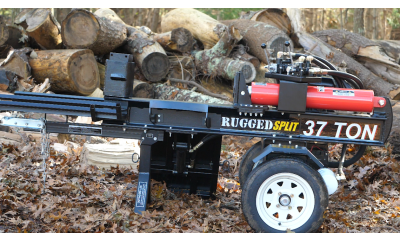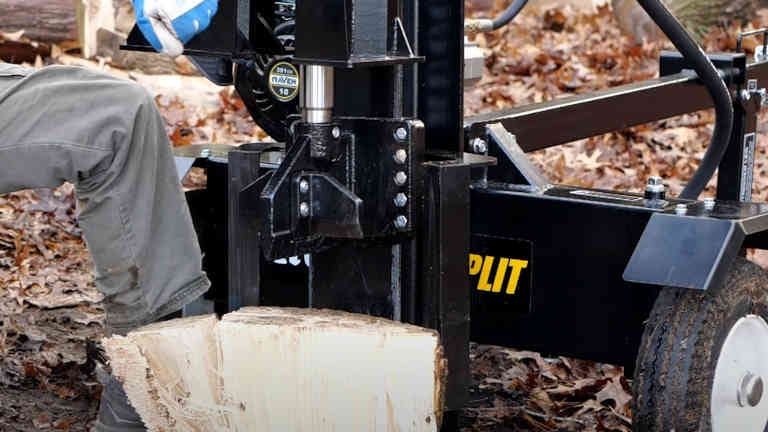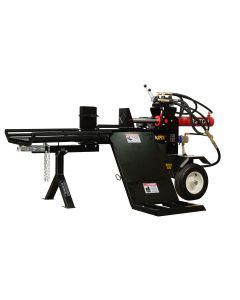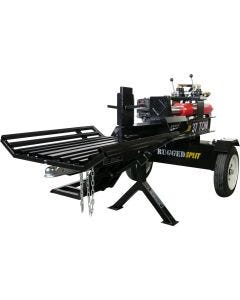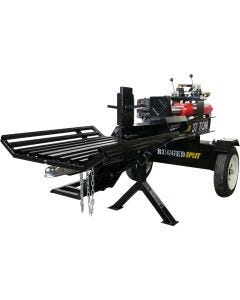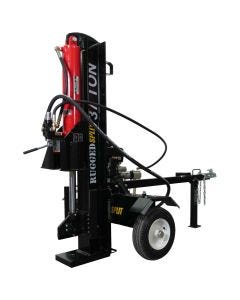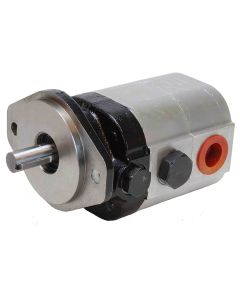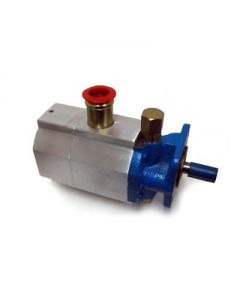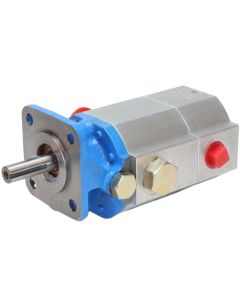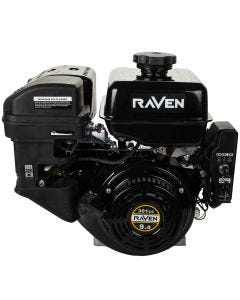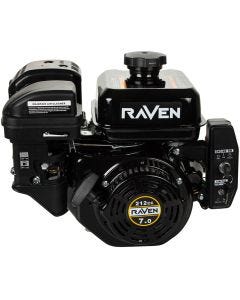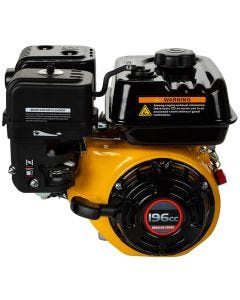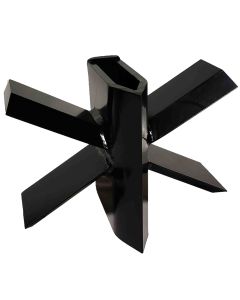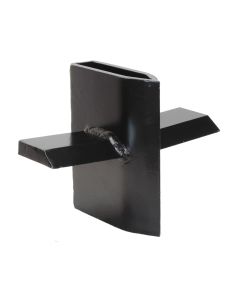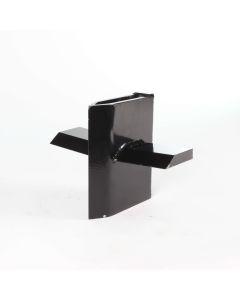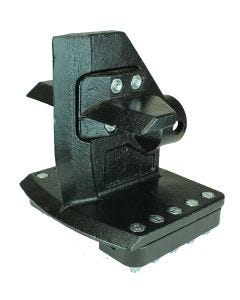

You have a lot of questions before you buy a wood splitter. Do I need power, speed, or both? How many tons of force do I need? We have the answers!
In this article, we'll address all the factors you need to consider when buying a log splitter:
How Many Tons of Force do You Need in a Log Splitter?
The first thing you need to determine when deciding what kind of log splitter to buy is how many tons of force you need. Do you need power, speed, or both? And what type of wood you split will be a significant factor in making this decision.
Softwood like pine, cedar, and cypress split easily and won't require much tonnage. If you mainly split soft, straight-grain, or dry, seasoned wood, 22-ton to 28 tons of power will suffice.
If slow-burning hardwood will be in your wood stove this winter, then how many tons of force your log splitter can produce is much more of a factor. Types of hardwood, like oak, ash, and poplar, require a little more power to split—especially a hardwood like elm, which is extremely difficult to split because of its interlocking grain.
A 37-ton splitter like the RS-537 or RS-737 will make short work of most variations of hardwood. With 37 tons of power, that "un-split-able" pile will start going away quickly. It has the tonnage to bust through large-diameter rounds and even handle that tough, green wood.
What is the Fastest Log Splitter?
The speed of your log splitter may be a more critical factor in your buying decision. With the RS-322-REX, a 22-ton log splitter, you will get an extremely fast cycle time of 10 seconds out and back (unloaded).
Thanks to good old fluid mechanics, the larger the rod OD, the faster it will retract, reducing overall cycle time. The cylinder's inner diameter (ID) and its rod's outer diameter (OD) is the specs that matter most.
Stroke will also be an important buying factor related to speed. If you need longer pieces of wood to burn more efficiently in your furnace or outdoor boiler, a log splitter with a 30" stroke is ideal. The 700 series models with 30-inch strokes are fast enough to compete with some wood processors. A two-person team can produce a cord of 30-inch wood to feed the hungriest outdoor boiler in an hour – sometimes less!
RuggedMade horizontal style log splitters come standard with another handy feature you won't get anywhere else: the stroke restrictor. With this device on your beam, you can reduce cycle time and split shorter rounds without making the rod travel more than it has to. For instance, the RS-700 Series splitters with 30" strokes can split 30" pieces of wood. But when you bolt the stroke restrictor onto the beam at the 24" slots, when the rod retracts on the return stroke, it will hit the stroke restrictor, popping the valve into neutral. A stroke restrictor saves 6 inches of unnecessary rod travel. Anyone who splits a lot of wood knows it's all about speed and efficiency!
How fast and powerful a log splitter is depends on its cylinder, power source, and pump. You can't get more power or speed by just increasing the size of one of these components, and all three are the heart and strength of any log splitter.
What Size Pump Does a Log Splitter Need?
The gallons per minute (GPM) of a pump on a log splitter should be almost twice the capacity of its hydraulic fluid reservoir. Our 700 series splitters have 12-gallon tanks, so we use 22 GPM pumps. By comparison, our 500 series, 37-ton splitters, have 8-gallon tanks and are matched with a 16 GPM pump. Be sure to check the minimum recommended engine size for a pump.
What Size Engine Should My Log Splitter Have?
The engine you put on your log splitter should be capable of turning a constant 3,600 RPM. This rate of speed is required for standard log splitter hydraulic pumps like ours. The engine size is also determined by the pump used. For example, the minimum engine size for a 13 GPM pump, as is found on most of our 22-ton log splitters, is 187-212cc or approximately 6.5 hp. While the smallest engine recommended to turn a 22 GMP pump, as is found on our RS-737 splitters, is 390cc or about 13 hp.
A cast iron sleeve and overhead valves (OHV) are specs of a true workhorse. Low oil sensors that stop your engine before you can do any damage are standard on a RuggedMade log splitter engine, taking that fear factor out of the picture.
The convenience of electric start is a no-brainer for those who have previously only dealt with pull start engines. Our electric start option will not break the bank like you may have seen with other sellers. We offer an excellent gel cell battery at a great price, so you know you are getting the right size and amps. Gel cell batteries are completely sealed (no assembly required), are maintenance-free, and are more resistant to vibration. Best of all - just like our hydraulic fluid and engine oil - batteries purchased with a log splitter ship free!
Log Splitter Blades
A 4-way blade is more than twice as fast as a simple blade. Once you split four ways, you will wonder why you never did before. RuggedMade log splitters all come standard with a 4-way blade because we are log splitter people, and we understand why you should not be without that feature.
If you think 4-way blades are a game-changer, wait until you experience the efficiency of our slip-on 6-way blade!
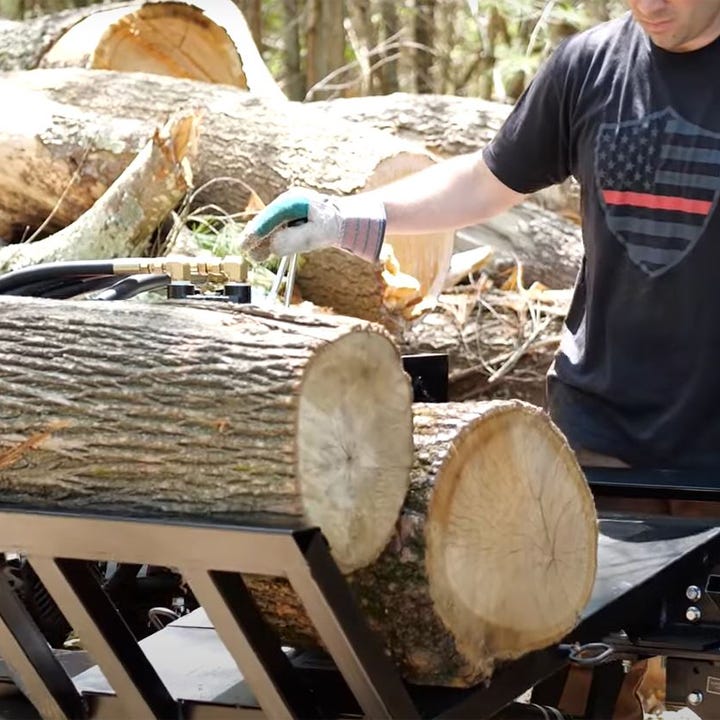

Is a Vertical or Horizontal Log Splitter Best?
Both types of log splitters can split logs that are too heavy to lift. Determining which type is best for you largely depends on your budget and whether you want to split large rounds on the ground.
The 300 and 700 series wood splitters are horizontal, or push-through, and come with a hydraulic log lift, making the back-breaking task of lifting logs onto the beam a thing of the past. The horizontal splitter design allows for a more efficient continuous flow of split wood onto a catcher tray or conveyor belt.
Horizontal/Vertical style splitters like our 500 series models that can tip up into a vertical work mode allow you to split a log on the ground that you do not want to lift onto the beam. It is a design feature that makes the machine cost less.
How to Choose a Log Splitter
Ergonomics
All our models are ergonomic and easy to configure for storage and towing. RuggedMade log splitters are all designed with the operator in mind. The location of every component on the splitter was considered, leaving room to stand and operate safely and comfortably.
With a waist-height work surface (about 31" from level ground to the top of the beam), bending over is minimized, and your back will thank you for that. Centrally mounted valves mean no unnatural reaching to work the controls and can be operated from either side. You can install our dual valve system on our 300 and 700 series models in your choice of multiple positions for truly personalized operation.
Log lifts can be installed on either side of the horizontal style models. Operators working solo usually install the log lift on the same side as the engine for convenient loading, splitting, and engine operation. When two or more people are working with the splitter, the log lift can be installed on the opposite side of the engine so people do not get in each other's way.
Quality
Heavy-Duty, Commercial Grade
RuggedMade products allow you to tackle the more challenging logs that light-duty splitters from big box stores cannot handle. Heavy gauge steel is used throughout, including structural steel beams, the tongue, the cradles, the log stripper, the blade, and the tank. Most of our steel is laser-cut (not stamped), and the precision and strength we put into the quality of our welds mean you are splitting with a machine that can stand the test of time.
Reducing friction points, or bottlenecks, may seem like overengineering, but it is an important performance factor that our competitors overlook. Oversize ports on valves and cylinders increase flow while reducing friction - in other words, heat. Heat an enemy of a log splitter's hydraulic system. It breaks down hydraulic fluid faster, leaving your hydraulic components vulnerable to blown seals and cavitation. That's why we've engineered our splitters to have a large fluid capacity and ¾-inch ports where it matters most, keeping hydraulic fluid cool and flowing freely.
Value
Our wood splitters are loaded with features and build quality, usually found only on machines three times the price. Yet, they're affordable for typical homeowner use, rancher/landowner, and the busy, independent firewood seller. We've been building log splitters the way we do for nearly 20 years because we use log splitters! A RuggedMade log splitter is built to last cord after cord, season after season.




